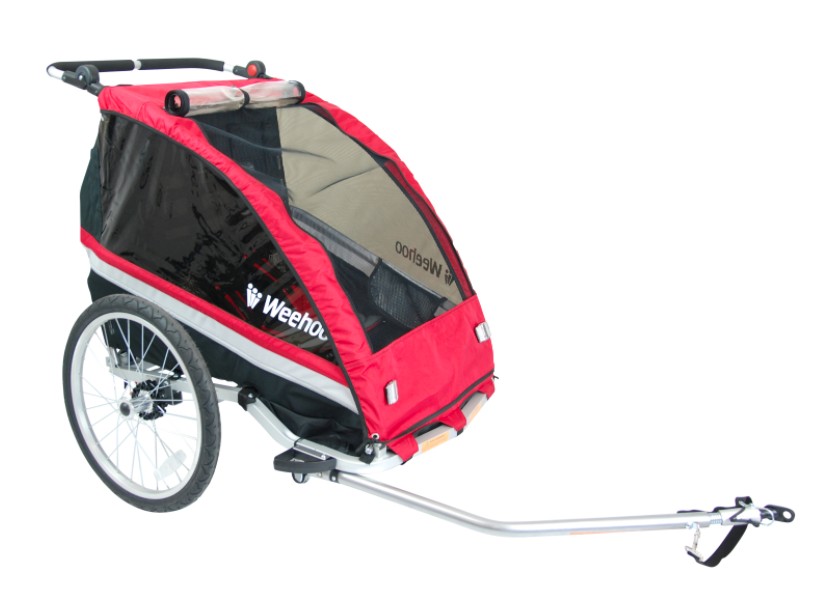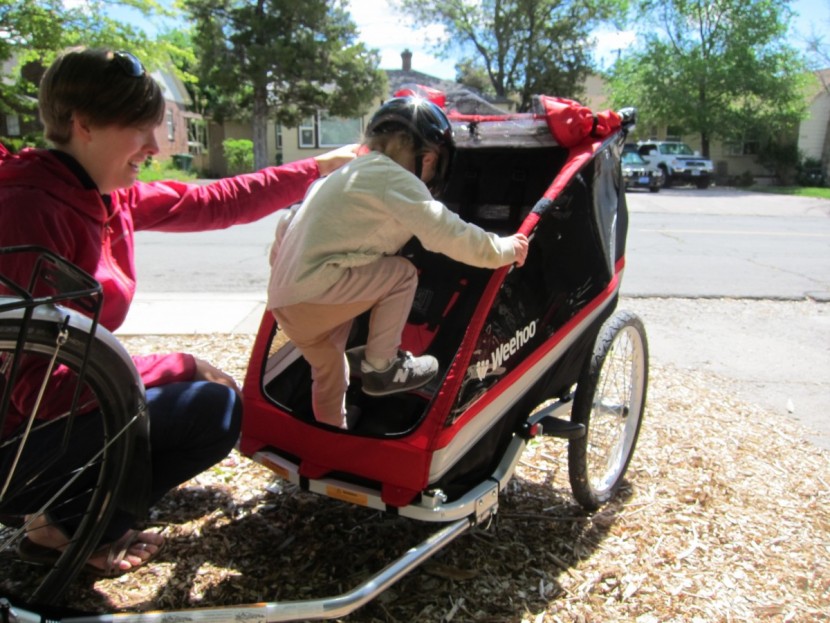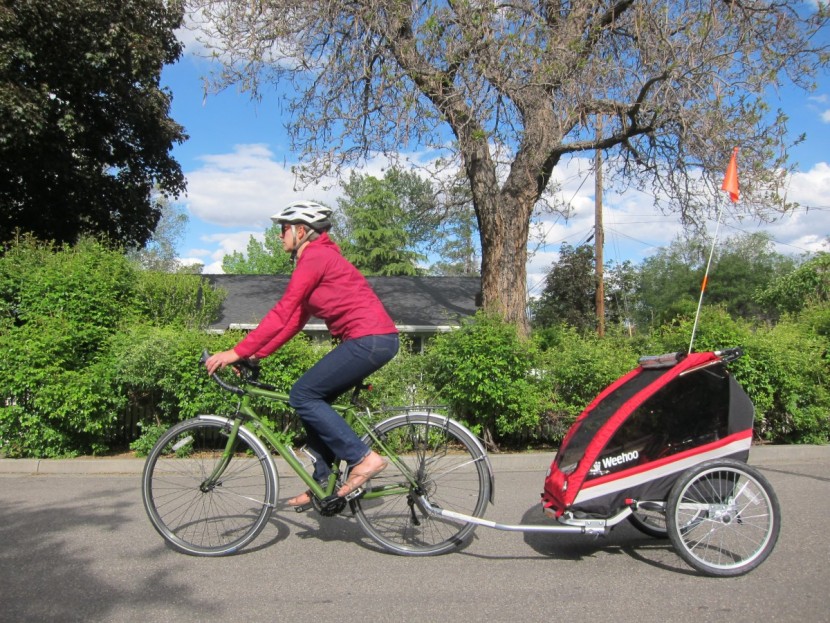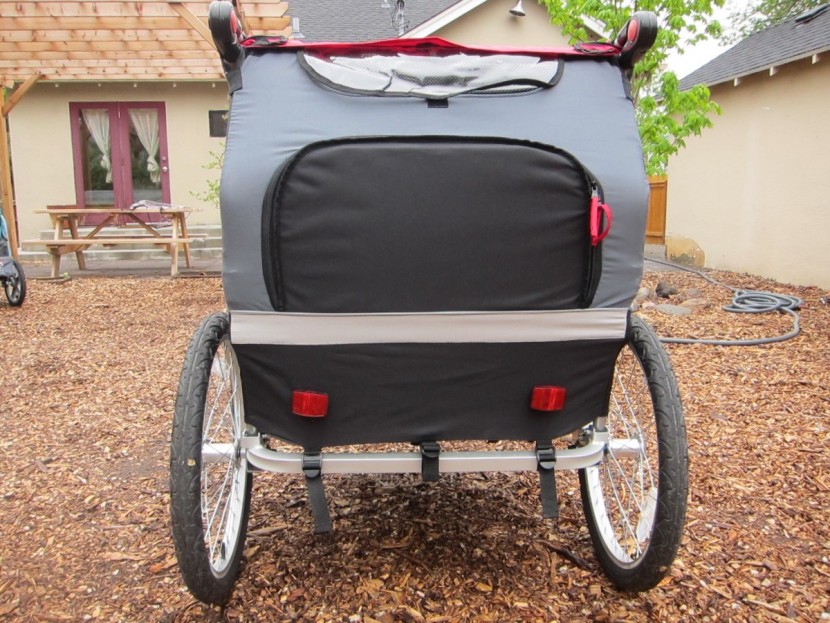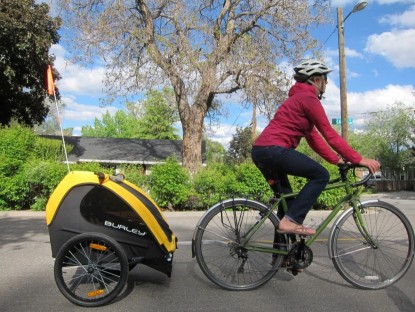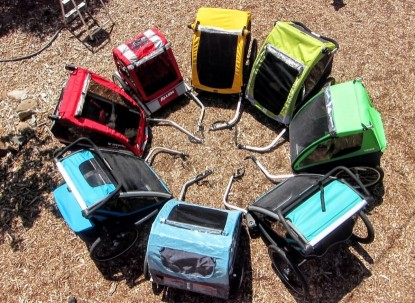Colorado-based Weehoo is best known for their beloved iGo Turbo pedal trailer, so we included their buggy-style trailer in our testing lineup to see if it performed as well. While we were impressed with the weeGo's safe construction, roomy interior, and padded passenger space, we ultimately didn't love this trailer. This was one of the most difficult products to assemble and use, and we found the rig to be unwieldy for the cyclist. The weeGo's yoke-style harness, the only one of its kind that we tested, took a long time to adjust and was unpleasant for our passengers. This is a big trailer, but the inflexible interior spaces limit its versatility.
For the same price, we think you'll have a better experience with our Best Bang for the Buck Award winner, the Burley Bee. If you want the large interior and padded seating area of the WeeGo and don't mind spending a little more, check out our Editor's Choice, the Burley D'Lite X.Weehoo weeGo Review
Our Verdict
Our Analysis and Test Results
Protection
The weeGo performed well in this category. In addition to meeting the safety standards set by the ASTM (as do all the trailers we tested), the weeGo has extra framing on top and back, which builds out the roll cage. This model has a rubber layer on the floor, which provides firm footing for passengers and adds extra protection from potential sharp objects on the road or trail. However, the weeGo has no suspension system, and the seat fabric seemed looser than that of other trailers, which allowed the test dummy to be jostled around much more. It provided little shock absorption.
The weeGo's front cover has a built-in sunshade, though it's not adjustable like the ones on the Burley D'Lite models and the Thule Chariots. The trailer is well-ventilated with a small mesh-covered window in the back to encourage airflow.
Passenger Experience
There is plenty of room for passengers in the weeGo — at 22.5", it has one of the wider seats in our test group. This trailer felt more wobbly than any of the others, likely because it's positioned so far back from the bicycle by its long tow arm, but the flat rubber footwell provided a nice stable surface for little feet as they entered and exited. The seat and harness are well-padded, although we did notice some wear in the seat fabric almost immediately, leading us to wonder how long it would hold up under frequent use.
The main reason the weeGo scored so poorly in this category is its harness, which includes a one-piece padded yoke that goes over the child's head. Adjusting the harness takes a lot of trial and error and requires unthreading the straps completely from their buckles, unwinding them from the cross-straps on the seat back, rethreading them and then repeating the whole process over again if further adjustments are needed.
Further, the yoke portion that goes over the child's head can be a tight squeeze if the harness isn't loose enough, which freaked our passenger testers out. This also means that the child's helmet must be put on after they're already strapped in, which adds a layer of hassle. This was the least user-friendly harness we tested; we much preferred the simple five-point over-the-shoulder style harnesses found most of the other trailers.
Biker Experience
The weeGo did not compete well in this category. The unwieldy bulk of the trailer made it just plain difficult to tow, and steep hills that were doable with other trailers felt almost impossible with the weeGo. Our testers noted significant lurching and feedback from the trailer to the bike, and this was by far the noisiest of the trailers we tested. The weeGo's extra long tow arm made the whole rig difficult to maneuver, especially when walking the bike through obstacles or navigating tight turns. We did appreciate the 20" wheels, which made this trailer easier to pull over rough terrain than the smaller-wheeled Allen Sports Steel and the InStep Take 2.
Ease of Use
It took us 30 minutes to assemble the weeGo, and most of that was spent trying to figure out how to snap the frame together. This requires reaching in through the back access flap and pulling the frame in place at an awkward angle — we never quite got the hang of this, and only the Thule Cadence had a more difficult frame to deal with. Breaking down the weeGo was slightly easier, but still require some contortions.
Like the Allen Sports Steel, the weeGo's hitch uses a male-female system so that the end of the trailer's tow arm slots over the protruding hitch and is held in place with a cotter pin. We found this hitch type the most difficult to use out of all the trailers we tested since it required lining the trailer up perfectly and leaning the bike over to match the angle of the hitch adaptor to the tow arm. Unlike the low-profile Allen, the weeGo is cumbersome and bulky, and we found that if the hitch adaptor wasn't secured as tightly as possible, the weight of the trailer would cause it to shift, which often knocked the bike's back wheel out of alignment. We found the Burley and Thule hitches to be much more user-friendly.
Versatility
The weeGo is a big trailer, so it's a great option for hauling large loads of groceries or other equipment. The footwell is quite recessed, and the interior doesn't have any flexibility for reconfiguration, so we found it difficult to level the space out for canine passengers. Although this trailer has one of the widest cargo areas we tested at 23", space can only be accessed through the 18"-wide back opening, which limits the utility of this ample space.
Best Applications
The weeGo is extra roomy inside and had a padded seating area for passengers, and its big 20" wheels can handle a little off-road riding. Since this trailer is tough to tow uphill and isn't the easiest to set up and break down, we think it would be a great option for long weekend rides on dedicated bike trails or flat gravel roads.
Value
With an MSRP of $229, this trailer is a step down in price from the Burley Bee and the Thule Cadence. However, its non-intuitive harness, overall bulk, and exceptionally long tow arm make this a difficult trailer to use every day, while the Bee and the Cadence are light and user-friendly enough to encourage daily use. Ultimately, we think the weeGo has too many design issues to justify its price.
Conclusion
The Weehoo weeGo is a solid performer in the safety category, but it falls down in every other metric we tested. We found it difficult to tow, tough to adjust for passengers, and relatively inflexible. If you know you'll only be using your trailer for flat weekend rec rides, you might consider it. For anything beyond that, there are better trailers on the market.


